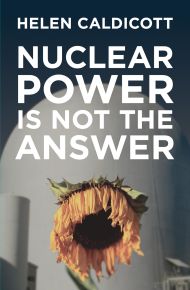 I’m sure by now many readers are getting tired of reading about Dr. Caldicott and her latest book “Nuclear Power is Not the Answer.” So if the readers can hang with me for one last post on the book I would really appreciate it.
I’m sure by now many readers are getting tired of reading about Dr. Caldicott and her latest book “Nuclear Power is Not the Answer.” So if the readers can hang with me for one last post on the book I would really appreciate it.Chapter 9 – Renewable Energy: The Answer
Caldicott, p. 161:
Many kinds of alternative solutions are currently on the drawing board because of the extreme urgency of countering global warming. For instance, the conversion of coal to a synthetic fuel, which can be used for transportation and which would contribute much less to global warming than petroleum, is actively being championed by Governor Brian Schweitzer of Montana.I don’t know about you but I’m a bit stunned to see that she would mention coal as a solution to climate change.
Caldicott, p. 161:
However, the world at large has already begun to shift over to alternative energy sources, as is documented in several recent studies…Globally, more electricity is now produced by decentralized, low-carbon or no-carbon competitors than from nuclear power plants-about one-third from renewables (wind, biomass, solar) and two-thirds through a very efficient form of energy production in which electricity is made from waste heat emanating from industry in a process called fossil-fuel combined-heat-and-power CHP, or cogeneration.For those readers who have been around for sometime you can probably guess whose ideas are these. If you guessed Amory Lovins you are correct. And if you’ve been around quite a bit you already know of the many posts we have written on Mr. Lovins and his ideas. I like his ideas about energy efficiency; however, when it comes to comparing to nuclear I find them way off. My opinion of course.
Back to Caldicott. Maybe I’m misinformed but I thought that “alternative energy sources” did not include natural gas which is the primary source of fuel for cogeneration. If she’s concerned about climate change, and she believes that nuclear produces only about one-third of the lifecycle emissions as natural gas, then why go for natural gas anyways. I find this puzzling.
Caldicott, p. 170:
It is imperative that the federal and state governments subsidize these important and critical new energy sources (wind).So she rails against subsidies for nuclear in Chapter 2 but states in Chapter 9 that “it is imperative” that wind receives subsidies. I have no problem with wind receiving subsidies but am a little confused by this logic. The way she made it sound for nuclear in Chapter 2 is that subsidies are bad. But in Chapter 9 subsidies are apparently appropriate for wind.
Chapter 10 – What Individuals Can Do: Energy Conservation and Efficiency
Caldicott, p. 175:
Europeans use approximately 50% less energy per capita than Americans, while maintaining the same standard of living…If Americans change the way they live and decide to take responsibility to clean up the polluted planet, millions will follow.Energy does not really have much to do with standard of living. It’s the consumption of electricity (ppt) that does. Regardless. I think she has a good point about conserving electricity. Do we really need to have lights on in rooms that aren’t even being used? Do we really need to have the AC set to 65 so our offices are so cold that we need heaters under our desks to keep warm? I don’t know the numbers specifically but conservation could go a long way. And the same goes with efficiency. According to EIA data (PDF), we saved less than 2 percent in 2004 utilizing demand side programs compared to what we generate in the U.S. I am sure we could do a lot better.
Think of electricity like water. Do you leave the faucet running when you’re not using it? Do you run the faucet while brushing your teeth? Same applies to electricity.
However, you still need a source to supply electricity and with a 45%-50% increase in electrical demand by 2030 projected in the U.S. (pdf), we are going to need all the supply available. Just to give an idea of the magnitude of the increase, think of adding about 300-350 new nuclear plants to the grid by 2030. That’s almost the current capacity of the world’s existing nuclear fleet (pdf). Not one source can scale up that fast to meet all that demand. And that’s exactly what NERC’s latest assessment states on page 7:
Long-term electricity supply adequacy requires a broad and balanced portfolio of generation and fuel types, transmission, demand response, renewables, and distributed generation; all supply-side and demand-side options need to be available.That is all from me. I hope the readers have enjoyed this debunking session over the past several weeks. For the previous posts on Dr. Caldicott’s book see below.
"Nuclear Power Is Not The Answer"
Dr. Caldicott vs. Nuclear Power, Round 1
Dr. Caldicott vs. Nuclear Power, Round 2
Dr. Caldicott vs. Nuclear Power, Round 3
Dr. Caldicott vs. Nuclear Power, Rounds Four and Five
Dr. Caldicott vs. Nuclear Power, Rounds Six, Seven and Eight
Technorati tags: Nuclear Energy, Nuclear Power, Electricity, Environment, Energy, Politics, Technology, Helen Caldicott
0 comments:
Post a Comment